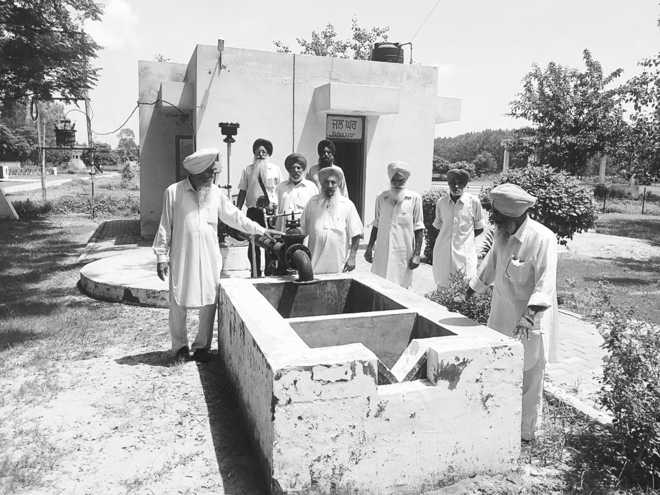
Residents of Singhpura village in Mohali at a water supply centre. A Tribune photo
Sanjeev Singh Bariana in Mohali
It is ironic that Punjab has had to reach sepulchral depths to get water in rural areas. The state government does not seem to have any plans to recharge groundwater. The fallout is scary: though drinking water is available at 300 ft, it has traces of microbes. So, government agencies, afraid to avoid health risks, go as deep as 800 ft. And villagers have no system other than bore-wells to irrigate their fields and meet domestic needs. In the absence of clean, tap-water supply from municipalities, villagers have to pool in money to set up bore-wells and overhead storage tanks. In several villages near Mohali, it is acceptance of the ground reality, a situation where governments step back leaving villagers to their fate.
The Central Groundwater Board (CGB) in 2012 noted that the water table is receding at an alarming rate of 30-40 cm per year in Punjab. Superintending hydro-geologist AK Bhatia, a scientist with CGB (north-west), had said groundwater recharging in places like Mohali involved rain and surplus water which is pumped into special structures directly put into the aquifer layers of the earth for storage purposes. Sadly, there is no knowing what happened to that plan.
Yet, villagers haven't accepted defeat — they have dug deeper and have found some support from the World Bank. They also have their own billing system. Mohali's Singhpura became the first village in the country to supply water 24x7 in February 2012. “Seven years ago, we, had to stay awake late at nights to store water for our daily needs. The supply came from nearby Lakhnaur village,” recalls former sarpanch Jagnahar Singh.
Similar are stories from Ghataur and Shahpur villages. The World Bank-aided project, worth around Rs 1,200 crore, was okayed in 2007. Today these villages have motorized extraction system in which water gushes out from bore-wells, dug up as deep as about 800 ft deep at Singhpura. The depth varies location-wise. The water is then pumped into an overhead tank with help of a motor. In Singhpura the tank has a capacity of 50,000 litres. Whenever the tank is has less than 50 per cent of its capacity, the motor pump starts automatically and re-fills the tank. When the tank is full, the motor shuts down automatically.
The villages have their own billing system: the base price is Rs 60. It is then charged Rs 5 per unit (1,000 litres). An average bill is for about Rs 120-150. These villages don't use municipal water, and have no regrets.
Secretary of the department of water supply and sanitation Jaspreet Kaur Talwar says in about five years, 104 villages have implemented the 24x7 supply system under different schemes offered by the World Bank and National Rural Drinking Water Supply Programme (NRDWP).
"Ever since a private contractor handed the keys to a village committee, we have never depended on the government office for anything, except technical assistance or in case of an emergency," says Maninder Kaur, treasurer of Ghataur village. The village committees at Ghataur and Shahpur have more than Rs 3.25 lakh surplus in their respective amounts.
Things are not working smoothly in a number of villages in different parts of the stat, official sources said. For example in Khizrabad and Theor villages in Mohali, where political differences are said to be the biggest cause of friction, leading to a failed system.
Singhpura village committee cashier Gurnam Singh says the village has 250 water connections in 181 houses. Bills are regularly paid by the 10th of each month. "We have a surplus of over Rs 3.83 lakh, which is used for maintenance and repair works."
In Ghataur, Maninder Kaur, managing the village accounts since the scheme began in 2012, works for gratis. The village has 248 water connections in 214 houses. Helped by committee members, the cashier is respected for her spotless account register. "Bahut strict hai ji. Esne te mainu vi nahin chhadiya" laughs the village panch Bhupinder Kaur, who has been fined at least twice for delay in depositing her bills.
In Shahpur, Harmanjit Kaur says the entire village is cooperating in the project execution. Our village has 183 homes and 215 connections. The records are open to all," says Barinder Kaur, a villager.



























